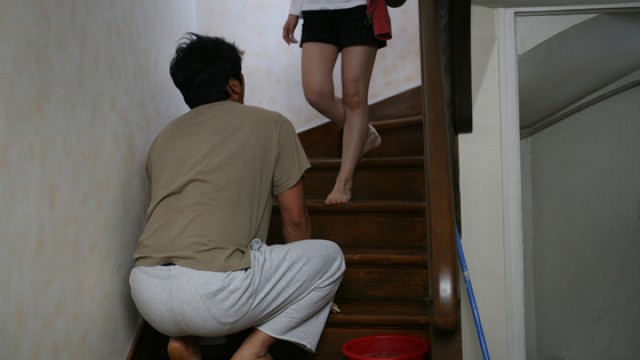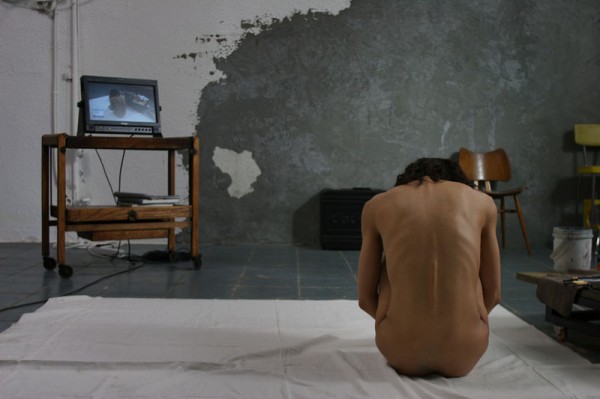NIGHT AND DAY (BAM GUAN NAT) (Hong Sangsoo, 2008)
Museum of the Moving Image
35th Ave. at 36th St., Astoria
Sunday, March 18, free with museum admission, 2:00
Series runs March 17-23
718-777-6800
www.movingimage.us
 Korean writer-director Hong Sang-soo returned to the New York Film Festival for the fifth time with Night and Day, a character-driven tale about displacement and loneliness. Youngho Kim stars as Sungam, a married painter in his forties who flees South Korea for France after having been turned in for smoking marijuana with U.S. tourists. A fish out of water in Paris, he settles into a Korean neighborhood, spending most of his time with two young art students, Yujeong (Eunhye Park) and Hyunju (Minjeong Seo). He also meets an old girlfriend, Minsun (Youjin Kim), who is still attracted to him. And every night he calls his wife, Sungin (Sujung Hwang), wondering when he’ll be able to return home. Hong (Woman Is the Future of Man, Tale of Cinema) tells the story in a diary-like manner, with interstitials acting like calendar pages. Sometimes a day can be filled with talk of art, a party, and a chance encounter, while others can consist of a brief, random event with no real bearing on the plot, reminiscent of Jim Jarmusch’s Stranger Than Paradise, just without the existential cynicism and dark humor. As with 2006’s Woman on the Beach, Hong lets Night and Day go on too long (it clocks in at 141 minutes), with too many inconsequential (even if entertaining) vignettes, but it’s so much fun watching Youngho’s compelling performance that you just might not care about the length. Night and Day is screening March 18 as part of the Museum of the Moving Image’s retrospective of Hong’s work, which also includes Like You Know It All, Woman on the Beach, Oki’s Movie, and The Day a Pig Fell into the Well.
Korean writer-director Hong Sang-soo returned to the New York Film Festival for the fifth time with Night and Day, a character-driven tale about displacement and loneliness. Youngho Kim stars as Sungam, a married painter in his forties who flees South Korea for France after having been turned in for smoking marijuana with U.S. tourists. A fish out of water in Paris, he settles into a Korean neighborhood, spending most of his time with two young art students, Yujeong (Eunhye Park) and Hyunju (Minjeong Seo). He also meets an old girlfriend, Minsun (Youjin Kim), who is still attracted to him. And every night he calls his wife, Sungin (Sujung Hwang), wondering when he’ll be able to return home. Hong (Woman Is the Future of Man, Tale of Cinema) tells the story in a diary-like manner, with interstitials acting like calendar pages. Sometimes a day can be filled with talk of art, a party, and a chance encounter, while others can consist of a brief, random event with no real bearing on the plot, reminiscent of Jim Jarmusch’s Stranger Than Paradise, just without the existential cynicism and dark humor. As with 2006’s Woman on the Beach, Hong lets Night and Day go on too long (it clocks in at 141 minutes), with too many inconsequential (even if entertaining) vignettes, but it’s so much fun watching Youngho’s compelling performance that you just might not care about the length. Night and Day is screening March 18 as part of the Museum of the Moving Image’s retrospective of Hong’s work, which also includes Like You Know It All, Woman on the Beach, Oki’s Movie, and The Day a Pig Fell into the Well.



 They don’t come much bigger than Orson Welles in Touch of Evil, as he nearly bursts through the frame as spectacularly dastardly police captain Hank Quinlan. So it is appropriate that the film is screening as part of the Museum of the Moving Image’s ongoing “See It Big!” series, where audiences can best appreciate the size and scope of Welles’s dark potboiler. A deliciously devious corrupt lawman, Quinlan is an enormous drunk who has no trouble breaking the rules to get his man. Charlton Heston took a lot of criticism playing Mike Vargas, a Mexican drug enforcement agent newly married to beautiful blonde Susan (Janet Leigh), who soon finds herself menaced by a dangerous gang as a weak-kneed, pre-McCloud Dennis Weaver looks the other way. The film famously opens with a remarkable crane shot that goes on for more than three minutes, setting the stage like no other establishing shot in the history of cinema. And the final scene with Marlene Dietrich as sultry hooker Tana is a lulu as well, highlighted by one of the great all-time movie lines. What goes on in between is a lurid tale of murder and revenge filled with unexpected twists and turns, featuring appearances by such Welles regulars as Joseph Cotten, Akim Tamiroff, Joseph Calleia, and Ray Collins. There was a lot of hype surrounding the film when it was recently restored to match Welles’s original desires, but the final product lives up to its billing. Touch of Evil is a deeply affecting noir masterpiece.
They don’t come much bigger than Orson Welles in Touch of Evil, as he nearly bursts through the frame as spectacularly dastardly police captain Hank Quinlan. So it is appropriate that the film is screening as part of the Museum of the Moving Image’s ongoing “See It Big!” series, where audiences can best appreciate the size and scope of Welles’s dark potboiler. A deliciously devious corrupt lawman, Quinlan is an enormous drunk who has no trouble breaking the rules to get his man. Charlton Heston took a lot of criticism playing Mike Vargas, a Mexican drug enforcement agent newly married to beautiful blonde Susan (Janet Leigh), who soon finds herself menaced by a dangerous gang as a weak-kneed, pre-McCloud Dennis Weaver looks the other way. The film famously opens with a remarkable crane shot that goes on for more than three minutes, setting the stage like no other establishing shot in the history of cinema. And the final scene with Marlene Dietrich as sultry hooker Tana is a lulu as well, highlighted by one of the great all-time movie lines. What goes on in between is a lurid tale of murder and revenge filled with unexpected twists and turns, featuring appearances by such Welles regulars as Joseph Cotten, Akim Tamiroff, Joseph Calleia, and Ray Collins. There was a lot of hype surrounding the film when it was recently restored to match Welles’s original desires, but the final product lives up to its billing. Touch of Evil is a deeply affecting noir masterpiece.


